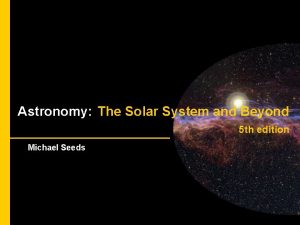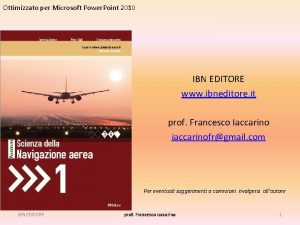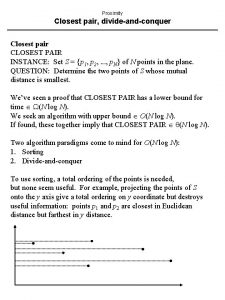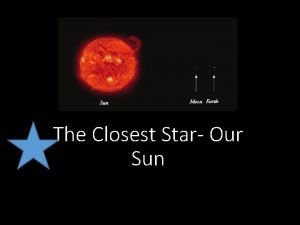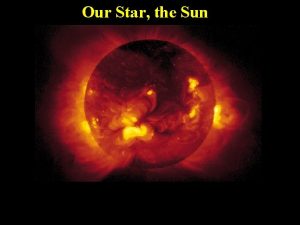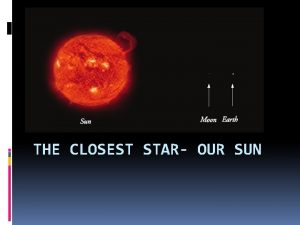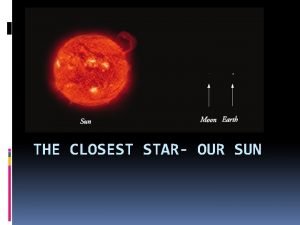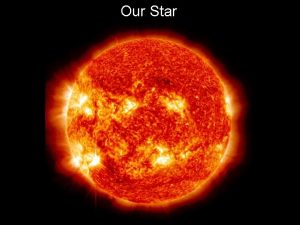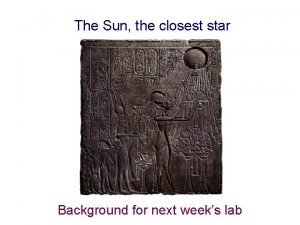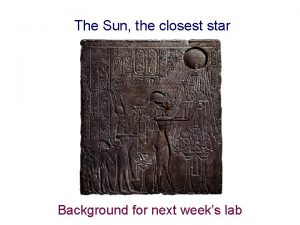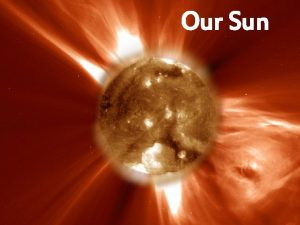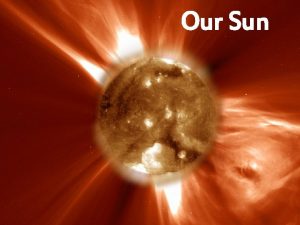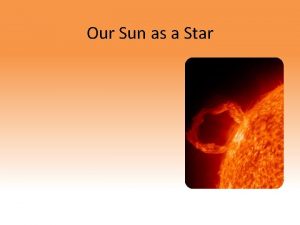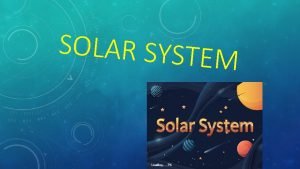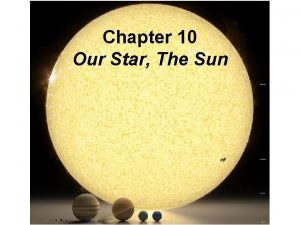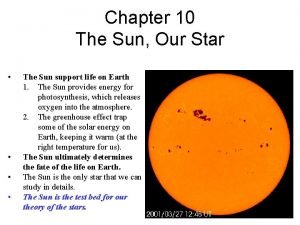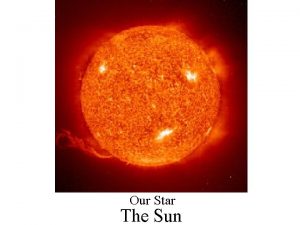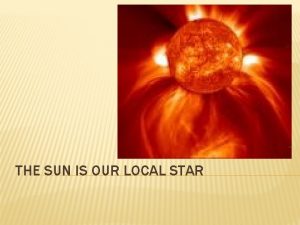The Sun The Sun Our closest star a





















- Slides: 21

The Sun

The Sun • Our closest star (a yellow dwarf) • Source of all energy on Earth • Located 149 million km from Earth or 1 AU (Astronomical Units) • Light takes a million years to get from the core to the Sun’s surface but only 8 minutes to reach us

The Sun • Rotates on its axis and orbits the galaxy, same as us • About half way through its 10 billion year life cycle • Sun will swell into a red giant, then cool to form a brown or black dwarf

The Sun

The Core • 25% of its radius • Intense pressure causes nuclear fusion – atoms of hydrogen fuse to form helium • Gives off huge amounts of energy (a billion 1 Mt nuclear blasts per second)

The Interior Radiative Zone • 45% of Sun’s radius • Energy carried out by photons (light energy) • Takes huge amount of time to get through

The Interior Convective Zone • 30% of Sun’s radius • Waves of hot gas • Carry energy outward to surface

The Atmosphere • Made up of 3 parts: the photosphere, the chromosphere, and the corona

The Atmosphere Photosphere • The surface of the Sun • 300 – 400 km wide • 6000˚ Celsius

The Atmosphere Chromosphere • Above photosphere (about 2000 km) • Convection currents cause temp. to rise to 10000˚ Celsius

The Atmosphere Corona • Extend millions of km out in space • Best seen during a solar eclipse or X-ray of the Sun • About 1000000˚C – perhaps due to Sun’s magnetism

Solar X-Ray Photosphere Chromosphere Corona

Other Features Sunspots • Darker, cooler regions on the surface • Intense magnetic field • Runs in an 11 year cycle (2010 is when sunspots are at a minimum)

Other Features Prominences • Clouds of gas from the chromosphere • Rise up along magnetic lines from sunspots Solar Flares • Violent eruptions from the Sun • Release intense radiation which cause auroras (Northern Lights)

Life of a Star • The fate of a star depends on its size Dwarf Stars • Like our sun, will swell up (red giant) then slowly burn out (white dwarf then black dwarf) • Will take several billion years

Fate of the Sun • http: //videos. howstuffworks. com/scienc e-channel/6566 -destiny-the-suns-fatevideo. htm

Life of a Star Huge or Giant Stars • Will become a supergiant, then explode into a supernova (core instantly collapses) • Eventually ends up as a neutron star or a black hole


Neutron Star • 1. 5 – 3 times mass of Sun • Core shrinks to diameter of 10 km, mass still double the Sun • Huge magnetic field and rapid spin

Black Hole • > 3 times mass of Sun • Contracts tremendously • Gravitation pull so strong not even light can escape!

 Bearing gifts we traverse afar
Bearing gifts we traverse afar Difference between ao* and a* algorithm
Difference between ao* and a* algorithm Fccla star events
Fccla star events Dark patch on our star
Dark patch on our star Many students work on the star our school newspaper
Many students work on the star our school newspaper Our life is what our thoughts make it
Our life is what our thoughts make it Our future is in our hands quotes
Our future is in our hands quotes Marcus aurelius our life is what our thoughts make it
Marcus aurelius our life is what our thoughts make it Summary of poem money madness
Summary of poem money madness Thinking affects our language which then affects our
Thinking affects our language which then affects our Our awareness of ourselves and our environment.
Our awareness of ourselves and our environment. We bow our hearts we bend our knees
We bow our hearts we bend our knees Awareness of ourselves and our environment is:
Awareness of ourselves and our environment is: Our census our future
Our census our future Awareness of ourselves and our environment is:
Awareness of ourselves and our environment is: Our census our future
Our census our future God our father christ our brother
God our father christ our brother Our awareness of ourselves and our environment is called
Our awareness of ourselves and our environment is called Bernadette farrell christ, be our light
Bernadette farrell christ, be our light Cpa closest point of approach
Cpa closest point of approach Closest companions of prophet muhammad
Closest companions of prophet muhammad Closest kohls
Closest kohls



